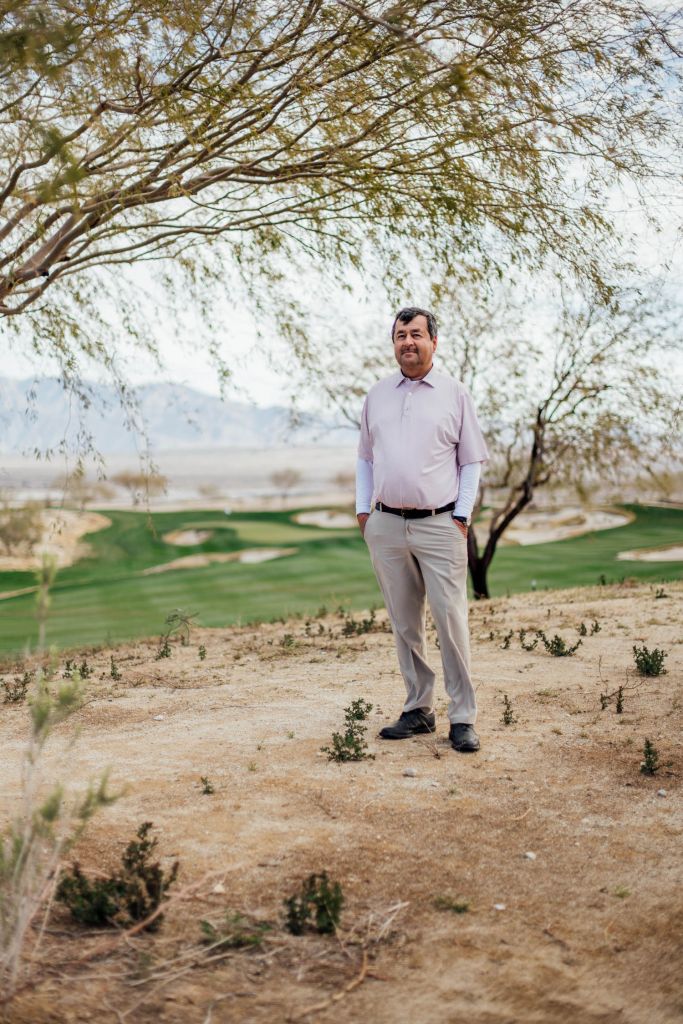After 30 years as a superintendent in Mexico, Las Vegas and the Coachella Valley, Willie Lopez knows better than most how to keep a golf course thriving in a climate that seems inhospitable to the game. The short answer: water, and lots of it. However, following one of the hottest summers ever recorded, Lopez is slashing water usage at Rams Hill Golf Club without sacrificing the supreme conditions that attract hardcore golfers to the Southern California desert.

TGJ: Describe Rams Hill for someone who’s never been there before.
WL: Rams Hill is down in the bottom of the low desert. We’re right about at sea level, right in the corner of San Diego County, Riverside County and Imperial Valley County in Anza-Borrego State Park. The course is right next to the mountains in some beautiful desert. You got a lot of ocotillos and just beautiful long desert views everywhere you look.
TGJ: Yes, from a quick look at Google Maps, it looks like there should not be a golf course there.
WL: It’s pretty remote here, and there are three other golf courses here in town, but they’re not like this. This is a Fazio design, a championship course. So we have people from San Diego, and a lot of play from Orange County and the Coachella Valley, but believe it or not, we have a small airport nearby and we get a lot of people who fly their private planes in here. We pick them up at the airport, bring them in for golf, and then they go back. We also have an area designated on the golf course for helicopters. People come down with their helicopters and land in the back of the driving range, right in the desert.
TGJ: Moving on to the climate side of things, it sounds like you’re in the middle of some major changes to the golf course?
WL: Yes, this summer we converted the greens from bentgrass to MiniVerde Bermudagrass.
It was a challenge in the summertime to maintain bentgrass. We did it, but it takes a great effort to have perfect putting surfaces for seven, eight months a year. This conversion is going to conserve water and allow us to keep the course open year round.
TGJ: How long did the transition take?
WL: We closed June 1, finished planting July 15, and we’re going to open back up in the first week in November. So we’ll have play from November through April, and then next summer we’re doing the same thing for the tees, fairways, and roughs —moving them from various bermudagrass strains to a new drought tolerant Bermudagrass strain: TifTuf.
TGJ: How much water will that save you?
WL: When we stabilize, we should save approximately 30%. That’s the primary reason we’re doing this—to conserve water.
TGJ: California water laws don’t mess around. What’s the story there?
WL: All of our water comes from wells. It’s not like the Coachella Valley where they get their water from the Colorado River. We have five wells on property; they’re all about 1,200 to 1,300 feet deep. All the rain and snow lands in the mountains, flows down and recharges the aquifer below us.
TGJ: What kind of water reporting is required?
WL: Every gallon that we suck out of the aquifer, we have to log with the Borrego Water District and the Borrego Watermaster. And every three months, we have to test the aquifer to see where the water level is. It’s pretty strict.



TGJ: It seems like weather patterns have become more extreme lately—have you dealt with that at Rams Hill?
WL: Yes. Just to give you an idea, this year, at the end of August, we’ve already had three and a half inches of rain, and a lot of that is from all the hurricanes we have had coming up from Baja. Now, looking at the past few years, over three inches by August actually looks like a lot of rain. But if you look historically, we’re actually short of where we should be, because we usually end up with about five inches per year. It’s just been tough to adjust on the fly.
TGJ: No doubt. And that’s a huge issue locally, because Rams Hill is a big employer in the area, correct?
WL: We employ about 90-something people. Most are local guys here from Borrego, and some of them are from other little towns close by, like Ocotillo Wells. We employ a large chunk of workforce in Borrego.
TGJ: Going forward, you have the new grass down and you’re planning for next year as well. Are there plans for more golf around there, another nine-hole or 18-hole course or something?
WL: We do have more golf planned. Our owner wants Rams Hill to be known as a world-renowned destination golf resort.
TGJ: Wow.
WL: We have a couple of hotels in town we partner with, plus we have accommodations here. You can rent a Golf House – a place to stay and come play golf. There’s plenty of room, and if another course comes online at some point, along with the golf cottages we have planned, it’s going to attract a lot more people.
TGJ: It’s the old Keiser quote: “One course is a curiosity, two is a destination.”
WL: Exactly, man. And we don’t have the ocean like Bandon, or the big trees like Pinehurst, but we have the beautiful desert. That’s all you need.

Related: Lowest Round Ever
Four hundred miles north of Rams Hill sits Furnace Creek Golf Course in Death Valley, CA—the hottest (and lowest) golf course on Earth. The TGJ Films team spent a 130-degree day with the men and women who call this golf course home.

















